source inside学习指导
- 格式:doc
- 大小:388.00 KB
- 文档页数:13
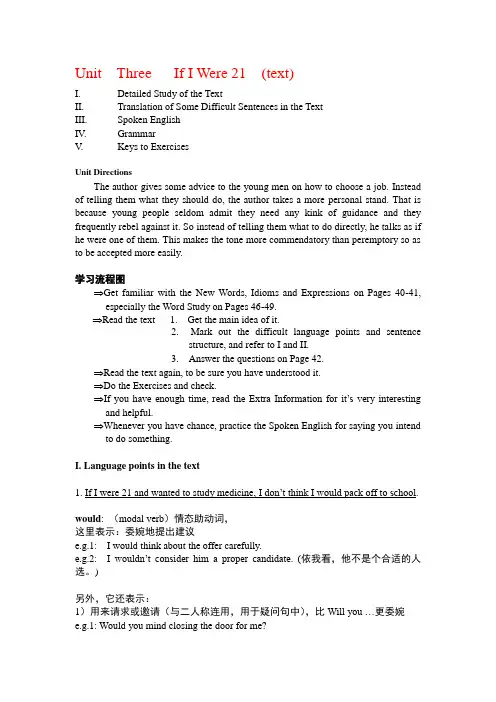
Unit Three If I Were 21 (text)I. Detailed Study of the TextII. Translation of Some Difficult Sentences in the TextIII. Spoken EnglishIV. GrammarV. Keys to ExercisesUnit DirectionsThe author gives some advice to the young men on how to choose a job. Instead of telling them what they should do, the author takes a more personal stand. That is because young people seldom admit they need any kink of guidance and they frequently rebel against it. So instead of telling them what to do directly, he talks as if he were one of them. This makes the tone more commendatory than peremptory so as to be accepted more easily.学习流程图⇒Get familiar with the New Words, Idioms and Expressions on Pages 40-41, especially the Word Study on Pages 46-49.⇒Read the text 1. Get the main idea of it.2. Mark out the difficult language points and sentencestructure, and refer to I and II.3. Answer the questions on Page 42.⇒Read the text again, to be sure you have understood it.⇒Do the Exercises and check.⇒If you h ave enough time, read the Extra Information for it’s very interesting and helpful.⇒Whenever you have chance, practice the Spoken English for saying you intend to do something.I. Language points in the text1. If I were 21 and wanted to study medicine, I don’t think I would pack off to school. would: (modal verb)情态助动词,这里表示:委婉地提出建议e.g.1: I would think about the offer carefully.e.g.2: I wouldn’t consider him a proper candidate. (依我看,他不是个合适的人选。
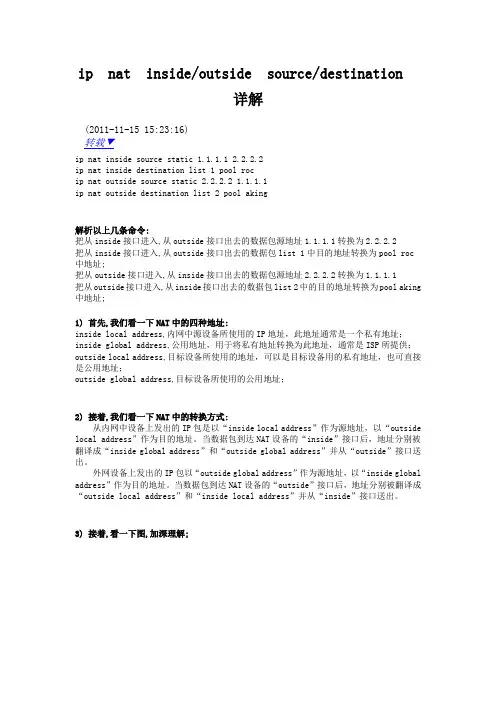
ip nat inside/outside source/destination详解(2011-11-15 15:23:16)转载▼ip nat inside source static 1.1.1.1 2.2.2.2ip nat inside destination list 1 pool rocip nat outside source static 2.2.2.2 1.1.1.1ip nat outside destination list 2 pool aking解析以上几条命令:把从inside接口进入,从outside接口出去的数据包源地址1.1.1.1转换为2.2.2.2把从inside接口进入,从outside接口出去的数据包list 1中目的地址转换为pool roc中地址;把从outside接口进入,从inside接口出去的数据包源地址2.2.2.2转换为1.1.1.1把从outside接口进入,从inside接口出去的数据包list 2中的目的地址转换为pool aking 中地址;1) 首先,我们看一下NAT中的四种地址:inside local address,内网中源设备所使用的IP地址,此地址通常是一个私有地址;inside global address,公用地址,用于将私有地址转换为此地址,通常是ISP所提供;outside local address,目标设备所使用的地址,可以是目标设备用的私有地址,也可直接是公用地址;outside global address,目标设备所使用的公用地址;2) 接着,我们看一下NAT中的转换方式:从内网中设备上发出的IP包是以“inside local address”作为源地址,以“outside local address”作为目的地址。
当数据包到达NAT设备的“inside”接口后,地址分别被翻译成“inside global address”和“outside global address”并从“outside”接口送出。

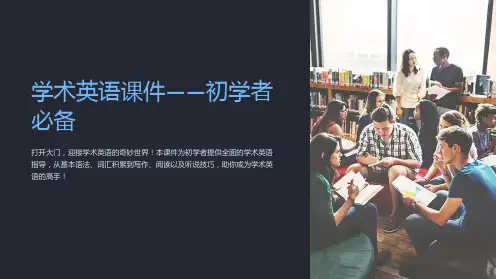
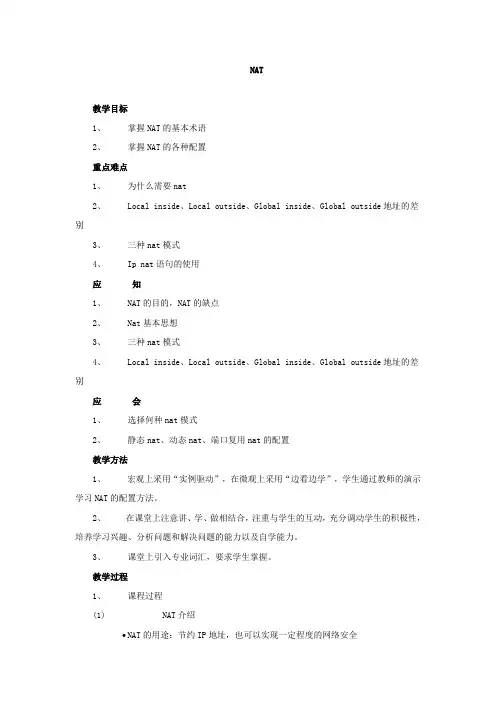
NAT教学目标1、掌握NAT的基本术语2、掌握NAT的各种配置重点难点1、为什么需要nat2、 Local inside、Local outside、Global inside、Global outside地址的差别3、三种nat模式4、 Ip nat语句的使用应知1、 NAT的目的,NAT的缺点2、 Nat基本思想3、三种nat模式4、 Local inside、Local outside、Global inside、Global outside地址的差别应会1、选择何种nat模式2、静态nat、动态nat、端口复用nat的配置教学方法1、宏观上采用“实例驱动”,在微观上采用“边看边学”,学生通过教师的演示学习NAT的配置方法。
2、在课堂上注意讲、学、做相结合,注重与学生的互动,充分调动学生的积极性,培养学习兴趣、分析问题和解决问题的能力以及自学能力。
3、课堂上引入专业词汇,要求学生掌握。
教学过程1、课程过程(1) NAT介绍NAT的用途:节约IP地址,也可以实现一定程度的网络安全∙NAT的缺点:失去了端到端的连接性∙NAT基本思路:边界路由器上改变源IP地址(2) 静态NAT的配置∙静态NAT实际上无法节约IP地址∙静态NAT的使用场合:通常用于实现外网可以访问内网∙Local inside、Local outside、Global inside、Global outside地址介绍∙Ip nat inside source static命令的使用∙Ip nat inside和ip nat outside命令∙Show ip nat translation(3) 动态NAT的配置∙动态NAT的基本原理∙动态NAT中的地址池定义:ip nat pool命令∙使用NAT功能的内部主机地址的定义:access-list命令∙Ip nat inside source list XX pool YY命令的使用(4) PAT的配置∙动态NAT和PAT的差别:pat技术不仅更改了源IP地址,还改变了端口号,提高了IP的利用率∙Ip nat inside source list XX pool YY overlad命令的使用(5) 根据实训项目14的要求完成实训项目142、小结∙介绍了NAT的概念和原理∙介绍了不同NAT模式的配置方法3、专业英语∙NAT:网络地址转换∙PAT:端口复用技术∙Local inside:本地内部地址∙Local outside:本地外部地址∙Global inside:全局内部地址∙Global outside:全局外部地址∙Nat pool:nat地址池4、课后作业∙提交实验报告(实训项目14)∙什么是NAT?∙NAT有几种类型?∙复用动态NAT与动态NAT的差别是什么?∙如何查看NAT的活跃的转换?∙如何清除NAT转换表中所有的动态地址转换条目?∙如何查看NAT转换的统计信息?∙如图,请按要求完成实验。
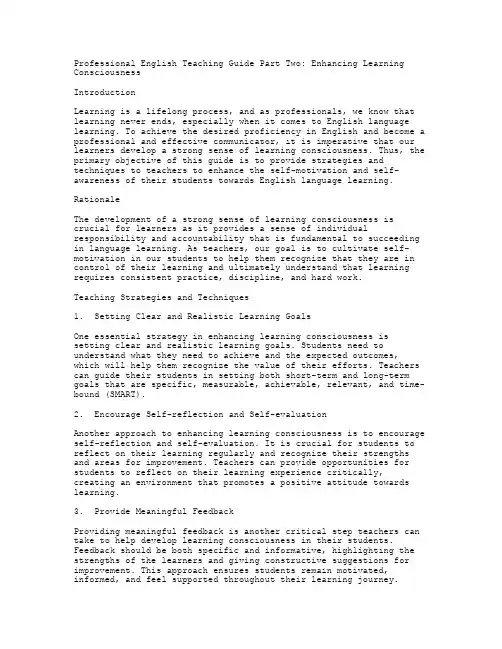
Professional English Teaching Guide Part Two: Enhancing Learning ConsciousnessIntroductionLearning is a lifelong process, and as professionals, we know that learning never ends, especially when it comes to English language learning. To achieve the desired proficiency in English and become a professional and effective communicator, it is imperative that our learners develop a strong sense of learning consciousness. Thus, the primary objective of this guide is to provide strategies and techniques to teachers to enhance the self-motivation and self-awareness of their students towards English language learning. RationaleThe development of a strong sense of learning consciousness iscrucial for learners as it provides a sense of individual responsibility and accountability that is fundamental to succeeding in language learning. As teachers, our goal is to cultivate self-motivation in our students to help them recognize that they are in control of their learning and ultimately understand that learning requires consistent practice, discipline, and hard work.Teaching Strategies and Techniques1.Setting Clear and Realistic Learning GoalsOne essential strategy in enhancing learning consciousness issetting clear and realistic learning goals. Students need to understand what they need to achieve and the expected outcomes, which will help them recognize the value of their efforts. Teachers can guide their students in setting both short-term and long-term goals that are specific, measurable, achievable, relevant, and time-bound (SMART).2.Encourage Self-reflection and Self-evaluationAnother approach to enhancing learning consciousness is to encourage self-reflection and self-evaluation. It is crucial for students to reflect on their learning regularly and recognize their strengths and areas for improvement. Teachers can provide opportunities for students to reflect on their learning experience critically,creating an environment that promotes a positive attitude towards learning.3.Provide Meaningful FeedbackProviding meaningful feedback is another critical step teachers can take to help develop learning consciousness in their students. Feedback should be both specific and informative, highlighting the strengths of the learners and giving constructive suggestions for improvement. This approach ensures students remain motivated, informed, and feel supported throughout their learning journey.4.Incorporate Collaborative Learning ActivitiesCollaborative learning activities can help enhance learning consciousness among students. By working together, learners acquire essential skills such as time management, problem-solving, decision-making, communication, and leadership skills. Through the exchangeof ideas and opinions, students develop an appreciation of thedifferent perspectives of others, fostering a sense of shared responsibility, and creating a climate of mutual support.e Real-world Examples and ApplicationsUsing real-world examples and applications is crucial in enhancing learning consciousness. Learners understand better when they canrelate the learning content to real-life situations. Teachers canuse a variety of real-world materials such as news articles, videos, podcasts, and case studies to help learners understand the practical applications of what they are learning.ConclusionIn conclusion, learning consciousness is a critical factor in astudent’s success in English language learning. By encouragingself-motivation, self-reflection, and self-evaluation, providing meaningful feedback, incorporating collaborative learning activities and real-world examples, teachers can create an environment that fosters a strong sense of learning consciousness among theirstudents. As professionals, we must continuously support ourlearners in building confidence and taking control of their learning, creating a foundation for life-long learning.。
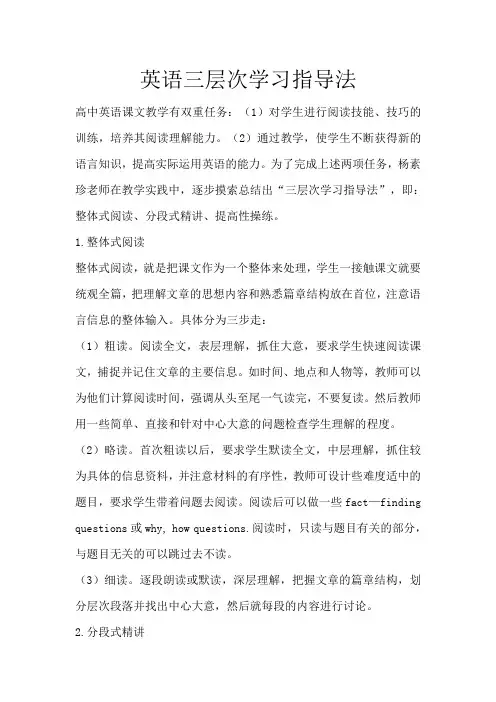
英语三层次学习指导法高中英语课文教学有双重任务:(1)对学生进行阅读技能、技巧的训练,培养其阅读理解能力。
(2)通过教学,使学生不断获得新的语言知识,提高实际运用英语的能力。
为了完成上述两项任务,杨素珍老师在教学实践中,逐步摸索总结出“三层次学习指导法”,即:整体式阅读、分段式精讲、提高性操练。
1.整体式阅读整体式阅读,就是把课文作为一个整体来处理,学生一接触课文就要统观全篇,把理解文章的思想内容和熟悉篇章结构放在首位,注意语言信息的整体输入。
具体分为三步走:(1)粗读。
阅读全文,表层理解,抓住大意,要求学生快速阅读课文,捕捉并记住文章的主要信息。
如时间、地点和人物等,教师可以为他们计算阅读时间,强调从头至尾一气读完,不要复读。
然后教师用一些简单、直接和针对中心大意的问题检查学生理解的程度。
(2)略读。
首次粗读以后,要求学生默读全文,中层理解,抓住较为具体的信息资料,并注意材料的有序性,教师可设计些难度适中的题目,要求学生带着问题去阅读。
阅读后可以做一些fact—finding questions或why, how questions.阅读时,只读与题目有关的部分,与题目无关的可以跳过去不读。
(3)细读。
逐段朗读或默读,深层理解,把握文章的篇章结构,划分层次段落并找出中心大意,然后就每段的内容进行讨论。
2.分段式精讲分段式精讲主要是学习课文中的语言知识点,引导学生分析较为复杂的语言现象。
学会重点,突破难点。
使学生的语言知识不断积累,学一篇课文,长一截知识,从而达到提高语言水平的目的。
在这个层次的教学中,教师要着重一个“精”字,学生要突出一个“练”字。
每课所讲的语言点不宜过多,但重点一定要讲深讲透,难点也必须解决。
在讲的同时,注意用造句、翻译和句型转换等练习给学生足够的操练,使语言知识当堂学习、当堂掌握。
此外,对课文还要评读,对作者的观点、写作方法、某些细节或精彩的句子教师要设疑提问,挖掘内蕴,及时地引导学生不断深化对课文的理解。
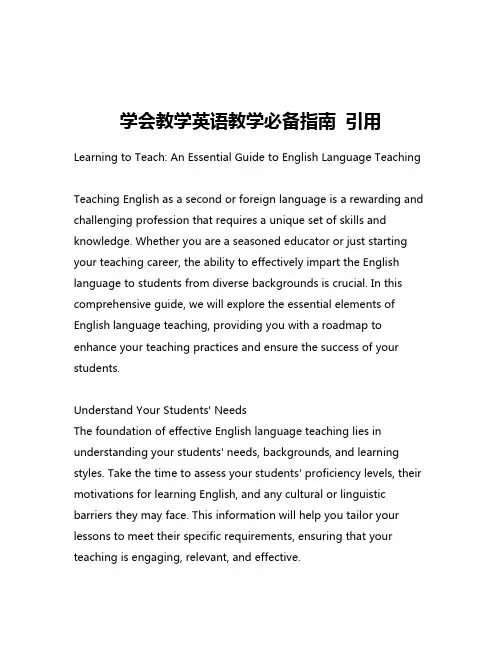
学会教学英语教学必备指南引用Learning to Teach: An Essential Guide to English Language TeachingTeaching English as a second or foreign language is a rewarding and challenging profession that requires a unique set of skills and knowledge. Whether you are a seasoned educator or just starting your teaching career, the ability to effectively impart the English language to students from diverse backgrounds is crucial. In this comprehensive guide, we will explore the essential elements of English language teaching, providing you with a roadmap to enhance your teaching practices and ensure the success of your students.Understand Your Students' NeedsThe foundation of effective English language teaching lies in understanding your students' needs, backgrounds, and learning styles. Take the time to assess your students' proficiency levels, their motivations for learning English, and any cultural or linguistic barriers they may face. This information will help you tailor your lessons to meet their specific requirements, ensuring that your teaching is engaging, relevant, and effective.Develop a Solid Pedagogical ApproachEffective English language teaching requires a strong pedagogical foundation. Familiarize yourself with various teaching methodologies, such as the communicative approach, task-based learning, and the direct method, and determine which approach or combination of approaches best suits your teaching context. Understanding the theoretical underpinnings of these methodologies will enable you to make informed decisions about lesson planning, classroom management, and assessment strategies.Foster a Communicative Classroom EnvironmentOne of the primary goals of English language teaching is to help students develop their communicative competence. Create a classroom environment that encourages active participation, risk-taking, and authentic communication. Incorporate a variety of interactive activities, such as role-plays, group discussions, and problem-solving tasks, that allow students to practice their speaking and listening skills in real-world contexts.Utilize Engaging and Diverse Teaching MaterialsCarefully select and design teaching materials that cater to the diverse learning needs of your students. This may include textbooks, authentic materials (e.g., news articles, videos, podcasts), and multimedia resources. Ensure that the content is engaging, relevant, and appropriately challenging, and that it aligns with your lessonobjectives and the overall curriculum.Incorporate Technology in Your LessonsIn the digital age, the integration of technology in the English language classroom can greatly enhance the learning experience. Explore the use of online platforms, educational apps, and multimedia tools to supplement your lessons, facilitate language practice, and provide opportunities for collaborative learning and independent study.Assess Student Progress EffectivelyOngoing assessment is crucial for monitoring student progress and adjusting your teaching strategies accordingly. Implement a variety of assessment methods, such as formative assessments (e.g., quizzes, classroom activities) and summative assessments (e.g., exams, projects), to evaluate your students' language proficiency, comprehension, and overall learning outcomes. Provide timely and constructive feedback to help your students identify their strengths and areas for improvement.Engage in Continuous Professional DevelopmentEffective English language teaching is an ongoing process that requires continuous learning and self-reflection. Engage in professional development opportunities, such as workshops, conferences, and online courses, to stay up-to-date with the latesttrends, research, and best practices in the field. Additionally, seek out peer-to-peer collaboration and mentorship to gain new insights and perspectives on your teaching practices.ConclusionBecoming an effective English language teacher is a journey of lifelong learning and self-improvement. By understanding your students' needs, developing a solid pedagogical approach, fostering a communicative classroom environment, utilizing engaging teaching materials, incorporating technology, assessing student progress effectively, and engaging in continuous professional development, you will be well on your way to providing your students with a transformative and enriching learning experience. Remember, the success of your students is a reflection of your own dedication and commitment to the art of English language teaching.。
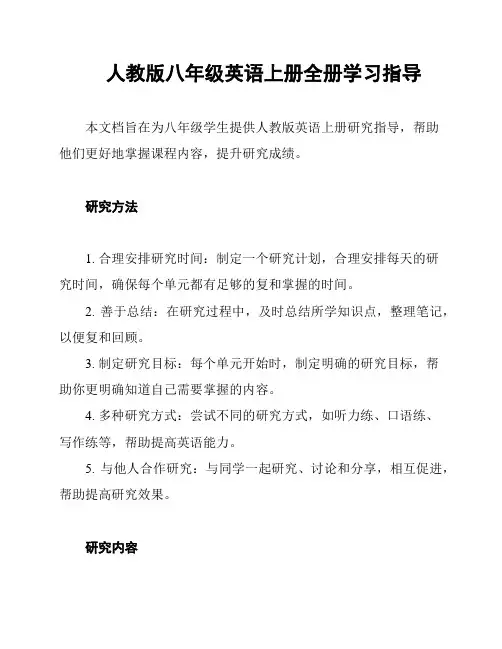
人教版八年级英语上册全册学习指导本文档旨在为八年级学生提供人教版英语上册研究指导,帮助他们更好地掌握课程内容,提升研究成绩。
研究方法1. 合理安排研究时间:制定一个研究计划,合理安排每天的研究时间,确保每个单元都有足够的复和掌握的时间。
2. 善于总结:在研究过程中,及时总结所学知识点,整理笔记,以便复和回顾。
3. 制定研究目标:每个单元开始时,制定明确的研究目标,帮助你更明确知道自己需要掌握的内容。
4. 多种研究方式:尝试不同的研究方式,如听力练、口语练、写作练等,帮助提高英语能力。
5. 与他人合作研究:与同学一起研究、讨论和分享,相互促进,帮助提高研究效果。
研究内容本册教材共分为若干单元,每个单元包括听说读写四个方面。
以下是各单元的研究要点:1. Unit 1: Greetings and Introductions- 学会用英语进行问候和自我介绍- 理解礼貌用语和文化差异- 研究如何描述人物特征和爱好2. Unit 2: School Life- 研究相关学校用语和日常表达- 能够描述学校设施和活动- 了解学校规则和班级活动3. ...(继续介绍其他单元的研究要点)研究辅助资料除了教材之外,推荐以下研究辅助资料,帮助学生更好地研究英语:1. 单词本:制作一个个人单词本,记录生词和常用短语,方便复。
2. 听力材料:听英语广播、音乐和影视剧,提升听力理解能力。
3. 英语研究网站:浏览一些英语研究网站,如BBC Learning English等,提供各种研究资源和练题。
希望本文档能对八年级学生的英语学习有所帮助。
祝愿大家学有所成!。
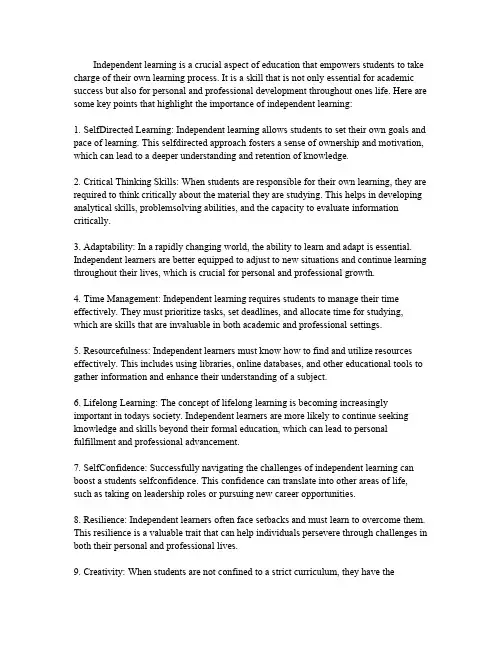
Independent learning is a crucial aspect of education that empowers students to take charge of their own learning process.It is a skill that is not only essential for academic success but also for personal and professional development throughout ones life.Here are some key points that highlight the importance of independent learning:1.SelfDirected Learning:Independent learning allows students to set their own goals and pace of learning.This selfdirected approach fosters a sense of ownership and motivation, which can lead to a deeper understanding and retention of knowledge.2.Critical Thinking Skills:When students are responsible for their own learning,they are required to think critically about the material they are studying.This helps in developing analytical skills,problemsolving abilities,and the capacity to evaluate information critically.3.Adaptability:In a rapidly changing world,the ability to learn and adapt is essential. Independent learners are better equipped to adjust to new situations and continue learning throughout their lives,which is crucial for personal and professional growth.4.Time Management:Independent learning requires students to manage their time effectively.They must prioritize tasks,set deadlines,and allocate time for studying, which are skills that are invaluable in both academic and professional settings.5.Resourcefulness:Independent learners must know how to find and utilize resources effectively.This includes using libraries,online databases,and other educational tools to gather information and enhance their understanding of a subject.6.Lifelong Learning:The concept of lifelong learning is becoming increasingly important in todays society.Independent learners are more likely to continue seeking knowledge and skills beyond their formal education,which can lead to personal fulfillment and professional advancement.7.SelfConfidence:Successfully navigating the challenges of independent learning can boost a students selfconfidence.This confidence can translate into other areas of life, such as taking on leadership roles or pursuing new career opportunities.8.Resilience:Independent learners often face setbacks and must learn to overcome them. This resilience is a valuable trait that can help individuals persevere through challenges in both their personal and professional lives.9.Creativity:When students are not confined to a strict curriculum,they have thefreedom to explore topics that interest them,which can lead to creative thinking and innovative problemsolving.10.Personalized Learning Experience:Each student has unique learning needs and preferences.Independent learning allows for a more personalized approach,where students can focus on areas they are passionate about or where they need additional support.In conclusion,independent learning is not just about acquiring knowledge it is about developing a set of skills that are essential for success in the modern world.It prepares students to be proactive,selfreliant,and adaptable individuals who can contribute positively to society.。
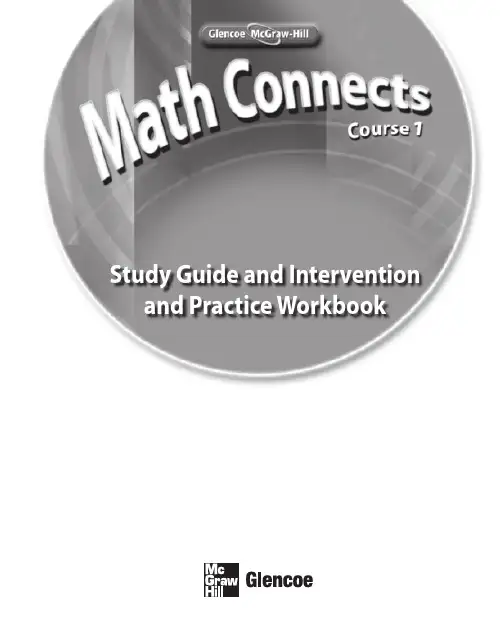
Study Guide and Intervention and Practice WorkbookTo the Student This Study Guide and Intervention and Practice Workbook gives you additional examples and problems for the concept exercises in each lesson.The exercisesare designed to aid your study of mathematics by reinforcing important mathematical skills needed to succeed in the everyday world.The materials are organized by chapter andlesson, with one Study Guide and Intervention and Practice worksheet for every lesson in Glencoe Math Connects, Course 1.Always keep your workbook handy.Along with your textbook, daily homework, and class notes, the completed Study Guide and Intervention and Practice Workbook can help you in reviewing for quizzes and tests.To the Teacher These worksheets are the same ones found in the Chapter Resource Masters for Glencoe Math Connects, Course 1.The answers to these worksheets areavailable at the end of each Chapter Resource Masters booklet as well as in your T eacher Wraparound Edition interleaf pages.Copyright ©by The McGraw-Hill Companies, Inc.All rights reserved.Except as permitted under the United States Copyright Act, no part of thispublication may be reproduced or distributed in any form or by any means, orstored in a database or retrieval system, without prior written permission of thepublisher.Send all inquiries to:Glencoe/McGraw-Hill8787 Orion PlaceColumbus, OH 43240ISBN:978-0-07-881032-9MHID:0-07-881032-9Study Guide and Intervention and Practice Workbook, Course 1 Printed in the United States of America1 2 3 4 5 6 7 8 9 10 009 13 12 11 10 09 08 07Lesson/Title Page 1-1 A Plan for Problem Solving (1)1-1 A Plan for Problem Solving (2)1-2Prime Factors (3)1-2Prime Factors (4)1-3Powers and Exponents (5)1-3Powers and Exponents (6)1-4Order of Operations (7)1-4Order of Operations (8)1-5Algebra:Variables and Expressions (9)1-5Algebra:Variables and Expressions (10)1-6Algebra:Functions (11)1-6Algebra:Functions (12)1-7Problem-Solving Investigation:Guess and Check (13)1-7Problem-Solving Investigation:Guess and Check (14)1-8Algebra:Equations (15)1-8Algebra:Equations (16)1-9Algebra:Area Formulas (17)1-9Algebra:Area Formulas (18)2-1Problem-Solving investigation:Make a T able (19)2-1Problem-Solving investigation:Make a T able (20)2-2Bar Graphs and Line Graphs (21)2-2Bar Graphs and Line Graphs (22)2-3Interpret Line Graphs (23)2-3Interpret Line Graphs (24)2-4Stem-and-Leaf Plots (25)2-4Stem-and-Leaf Plots (26)2-5Line Plots (27)2-5Line Plots (28)2-6Mean (29)2-6Mean (30)2-7Median, Mode and Range (31)2-7Median, Mode and Range (32)2-8Selecting an Appropriate Display (33)2-8Selecting an Appropriate Display (34)2-9Integers and Graphing (35)2-9Integers and Graphing (36)3-1Representing Decimals (37)3-1Representing Decimals (38)3-2Comparing and Ordering Decimals (39)3-2Comparing and Ordering Decimals (40)3-3Rounding Decimals (41)3-3Rounding Decimals (42)3-4Estimating Sums and Differences (43)3-4Estimating Sums and Differences (44)3-5Adding and Subtracting Decimals (45)3-5Adding and Subtracting Decimals (46)3-6Multiplying Decimals by WholeNumbers (47)3-6Multiplying Decimals by WholeNumbers..............................................48Lesson/Title Page 3-7Multiplying Decimals (49)3-7Multiplying Decimals (50)3-8Dividing Decimals by WholeNumbers (51)3-8Dividing Decimals by WholeNumbers (52)3-9Dividing by Decimals (53)3-9Dividing by Decimals (54)3-10Problem-Solving Investigation:Reasonable Answers (55)3-10Problem-Solving Investigation:Reasonable Answers (56)4-1Greatest Common Factor (57)4-1Greatest Common Factor (58)4-2Simplifying Fractions (59)4-2Simplifying Fractions (60)4-3Mixed Numbers and ImproperFractions (61)4-3Mixed Numbers and ImproperFractions (62)4-4Problem-Solving Investigation:Makean Organized List (63)4-4Problem-Solving Investigation:Makean Organized List (64)4-5Least Common Multiple (65)4-5Least Common Multiple (66)4-6Comparing and Ordering Fractions (67)4-6Comparing and Ordering Fractions (68)4-7Writing Decimals as Fractions (69)4-7Writing Decimals as Fractions (70)4-8Writing Fractions as Decimals (71)4-8Writing Fractions as Decimals (72)4-9Algebra:Ordered Pairs andFunctions (73)4-9Algebra:Ordered Pairs andFunctions (74)5-1Rounding Fractions and MixedNumbers (75)5-1Rounding Fractions and MixedNumbers (76)5-2Problem-Solving Investigation:Act It Out (77)5-2Problem-Solving Investigation:Act It Out (78)5-3Adding and Subtracting Fractionswith Like Denominators (79)5-3Adding and Subtracting Fractionswith Like Denominators (80)5-4Adding and Subtracting Fractionswith Unlike Denominators (81)5-4Adding and Subtracting Fractionswith Unlike Denominators (82)5-5Adding and Subtracting MixedNumbers (83)CONTENTSiiiLesson/Title Page 5-5Adding and Subtracting MixedNumbers (84)5-6Estimating Products of Fractions (85)5-6Estimating Products of Fractions (86)5-7Multiplying Fractions (87)5-7Multiplying Fractions (88)5-8Multiplying Mixed Numbers (89)5-8Multiplying Mixed Numbers (90)5-9Dividing Fractions (91)5-9Dividing Fractions (92)5-10Dividing Mixed Numbers (93)5-10Dividing Mixed Numbers (94)6-1Ratios and Rates (95)6-1Ratios and Rates (96)6-2Ratio T ables (97)6-2Ratio T ables (98)6-3Proportions (99)6-3Proportions (100)6-4Algebra:Solving Proportions (101)6-4Algebra:Solving Proportions (102)6-5Problem-Solving Investigation:Lookfor a Pattern (103)6-5Problem-Solving Investigation:Lookfor a Pattern (104)6-6Sequences and Expressions (105)6-6Sequences and Expressions (106)6-7Proportions and Equations (107)6-7Proportions and Equations (108)7-1Percents and Fractions (109)7-1Percents and Fractions (110)7-2Circle Graphs (111)7-2Circle Graphs (112)7-3Percents and Decimals (113)7-3Percents and Decimals (114)7-4Probability (115)7-4Probability (116)7-5Constructing Sample Spaces (117)7-5Constructing Sample Spaces (118)7-6Making Predictions (119)7-6Making Predictions (120)7-7Problem-Solving Investigation:Solvea Simpler Problem (121)7-7Problem-Solving Investigation:Solvea Simpler Problem (122)7-8Estimating with Percents (123)7-8Estimating with Percents (124)8-1Length in the Customary System (125)8-1Length in the Customary System (126)8-2Capacity and Weight in theCustomary System (127)8-2Capacity and Weight in theCustomary System (128)8-3Length in the Metric System (129)8-3Length in the Metric System (130)8-4Mass and Capacity in the MetricSystem (131)Lesson/Title Page 8-4Mass and Capacity in the MetricSystem (132)8-5Problem-Solving Investigation:UseBenchmarks (133)8-5Problem-Solving Investigation:UseBenchmarks (134)8-6Changing Metric Units (135)8-6Changing Metric Units (136)8-7Measures of Time (137)8-7Measures of Time (138)8-8Measures of T emperature (139)8-8Measures of T emperature (140)9-1Measuring Angles (141)9-1Measuring Angles (142)9-2Estimating and Drawing Angles (143)9-2Estimating and Drawing Angles (144)9-3Angle Relationships (145)9-3Angle Relationships (146)9-4T riangles (147)9-4T riangles (148)9-5Quadrilaterals (149)9-5Quadrilaterals (150)9-6Problem-Solving Investigation:Draw a Diagram (151)9-6Problem-Solving Investigation:Draw a Diagram (152)9-7Similar and Congruent Figures (153)9-7Similar and Congruent Figures (154)10-1Perimeter (155)10-1Perimeter (156)10-2Circles and Circumferences (157)10-2Circles and Circumferences (158)10-3Area of Parallelograms (159)10-3Area of Parallelograms (160)10-4Area of T riangles (161)10-4Area of T riangles (162)10-5Problem-Solving Investigation:Make a Model (163)10-5Problem-Solving Investigation:Make a Model (164)10-6Volume of Rectangular Prisms (165)10-6Volume of Rectangular Prisms (166)10-7Surface Area of Rectangular Prisms..167 10-7Surface Area of Rectangular Prisms..168 11-1Ordering Integers (169)11-1Ordering Integers (170)11-2Adding Integers (171)11-2Adding Integers (172)11-3Subtracting Integers (173)11-3Subtracting Integers (174)11-4Multiplying Integers (175)11-4Multiplying Integers (176)11-5Problem-Solving investigation:Workbackward (177)11-5Problem-Solving investigation:Workbackward (178)ivLesson/Title Page 11-6Dividing Integers (179)11-6Dividing Integers (180)11-7The Coordinate Plane (181)11-7The Coordinate Plane (182)11-8T ranslations (183)11-8T ranslations (184)11-9Reflections (185)11-9Reflections (186)11-10Rotations (187)11-10Rotations (188)12-1The Distributive Property (189)12-1The Distributive Property (190)12-2Simplifying Algebraic Expressions (191)12-2Simplifying Algebraic Expressions (192)12-3Solving Addition Equations (193)12-3Solving Addition Equations (194)12-4Solving Subtraction Equations (195)12-4Solving Subtraction Equations (196)12-5Solving Multiplication Equations (197)12-5Solving Multiplication Equations (198)12-6Problem-Solving Investigation:Choose the Best Method ofComputation (199)12-6Problem-Solving Investigation:Choose the Best Method ofComputation (200)v1-1 Example 1 Exercises1-1PATTERNS Complete each pattern.1-2 Example 1 Example 2 Exercises1-2Tell whether each number is1-3Example 1 Example 2 Example 3 ExercisesWrite each product using an exponent.Example 1 Example 2ExercisesFind the value of each expression.Example 1 Example 2 Example 3 Example 4 ExercisesExample 1 Example 2 ExercisesComplete each function table.Example 1 ExerciseMixed Problem SolvingUse the guess and check strategy toExample 1 Example 2 ExercisesIdentify the solution of each equation from the list given.Example 1 Example 2 ExercisesFind the area of each rectangle.Example 1 ExerciseMixed Problem SolvingUse the make a table strategy to solveExample 1 Example 2 Exercises1.ANIMALSExample 1 ExercisesSPORTS For Exercises 1–3,Example 1 ExerciseMake a stem-and-leaf plot for each set of data.Example 1Example 2 ExercisesPRESIDENTS For Exercises 1–4,Example 1 Example 2 ExercisesFind the mean of the data represented in each model.Example 1 Example 2 ExercisesFind the median,Example 1Example 2 Exercises1.FOOD Which display makes it easier to see theExample 1 Example 2 ExercisesWrite an integer to represent each situation.Example 2 Example 1ExercisesWrite each decimal in word form.Example 1 Example 2 ExercisesExample 1 Example 2 ExercisesRound each decimal to the indicated place-value position.Example 1 Example 2 ExercisesEstimate using rounding.Example 1 Example 2 Exercises。
Learning pressure is an inevitable part of the educational journey for many students around the world.It stems from various sources such as academic expectations,parental aspirations,and societal norms.Here,we will explore the different aspects of learning pressure and its impact on students.Understanding the Sources of Learning Pressure1.Academic Expectations:Students often face pressure to perform well in exams and assignments to meet the high standards set by educational institutions.This pressure can be exacerbated by competitive environments where grades are the primary measure of success.2.Parental Aspirations:Parents may have high hopes for their childrens academic achievements,which can lead to additional stress.The desire to make parents proud and fulfill their dreams can weigh heavily on students.3.Societal Norms:Society often places a premium on academic success,with certain careers and lifestyles being associated with high educational attainment.This societal pressure can influence students to strive for excellence in their studies.Effects of Learning Pressure on Students1.Mental Health:Prolonged stress can lead to anxiety,depression,and other mental health issues.Students under constant pressure may find it difficult to relax and enjoy their youth.2.Physical Health:The stress can also manifest physically,causing sleep disturbances, headaches,and a weakened immune system.3.Academic Performance:Ironically,while pressure is intended to motivate,it can sometimes have the opposite effect.Overwhelmed by stress,some students may underperform in exams due to test anxiety or a lack of focus.4.Social Life:The pressure to excel academically can leave students with little time for social activities,impacting their ability to form and maintain friendships.Coping Strategies for Learning Pressure1.Time Management:Effective time management can help students balance their academic workload with leisure activities,reducing stress.2.Seeking Support:Talking to teachers,counselors,or peers about the pressures they are facing can provide emotional relief and practical advice.3.Mindfulness and Relaxation Techniques:Practices such as meditation,yoga,and deep breathing can help students manage stress and maintain focus.4.Setting Realistic Goals:Instead of striving for perfection,setting attainable goals can reduce the pressure and increase the likelihood of success.5.Engaging in Physical Activity:Regular exercise is known to release endorphins,which can improve mood and reduce stress levels.ConclusionWhile learning pressure is a common experience for students,it is essential to recognize its potential negative impacts and develop strategies to cope with it effectively.By doing so,students can maintain a healthy balance between their academic pursuits and overall wellbeing.。
八年级英语非谓语动词作宾补练习题30题1<背景文章>Tom is a student in Grade Eight. He was having a hard time understanding non-finite verbs used as object complements. One day, he went to his English teacher, Miss Li, for help. Miss Li patiently explained to him the different forms and usages of non-finite verbs as object complements. She gave him several examples and asked him to practice. Tom listened carefully and started to do the exercises. After a while, he found that he could understand it better. He was very grateful to Miss Li for her help.1. Tom went to Miss Li for help because he _______ non-finite verbs used as object complements.A. was interested inB. was good atC. had a hard time understandingD. didn't care about答案:C。
中文解析:文章中提到“He was having a hard time understanding non-finite verbs used as object complements. One day, he went to his English teacher, Miss Li, for help.”,所以Tom 是因为理解非谓语动词作宾补有困难才去找老师帮助,答案是C。
新编英语教程1学习指南pdf The New English Course 1 Study Guide is designed to assist students in mastering the English language. With a focus on practical and effective learning methods, this guide aims to help students improve their speaking, listening, reading, and writing skills.The study guide is divided into several sections, each focusing on a different aspect of the English language. The first section covers basic grammar and vocabulary, providing students with a solid foundation for further learning. This section also includes exercises andactivities to reinforce the concepts covered.The second section of the study guide focuses on listening and speaking skills. Students will have the opportunity to practice their listening comprehension and speaking abilities through a variety of exercises and activities. This section also includes tips and strategies for improving pronunciation and fluency.The third section of the study guide is dedicated to reading comprehension. Students will have the chance toimprove their reading skills through a series of texts and comprehension questions. This section also includes vocabulary-building exercises to help students expand their word knowledge.The final section of the study guide focuses on writing skills. Students will learn how to structure and organize their writing, as well as how to effectively express their ideas in English. This section also includes writingprompts and exercises to help students practice theirskills.Overall, this study guide provides a comprehensive and structured approach to learning English. By following the guidance and completing the exercises, students can make significant progress in their language learning journey.新编英语教程1学习指南旨在帮助学生掌握英语语言。
Study Guide On Actsby Dr. Manford G. GutzkeThis study guide is designed to lead into a better grasp and a deeper understanding of the Acts of the Apostles.Because the text itself is part of the Holy Scriptures, which are taken to be the only authority, and the student is the one to whom the Word of God is sent, the questions are arranged to lead into the study of what Luke has written, and to challenge the student to reflect on the obvious meaning. Thus this guide is deliberately designed for personal use with the Scripture alone, and for personal reflection upon what has been written.This study guide would be suitable for use in group study. You are encouraged to have a neighborhood Bible study group in your home. It can also serve as a useful aid in a Church Bible Class.Other Aids"Plain Talk On Acts" has been prepared for the student. This study guide shows page numbers in parenthesis with some of the questions. These references are to pages in "Plain Talk On Acts."Some Suggestions- Pray expectantly before you begin study, whether alone or in a group.- Read the passage to be studied more than once. Ask yourself --What does this passage say? What does it mean to believers? Whatdoes it mean to me, personally?- Try to let God speak to you through His Word. Use commentaries onlyafter you have studied the passage in the text, and have noted what itseems to say to you. Do not read out of the commentaries to the group --read the Bible.- In group study start on time, and stick to the passage being studied. Askfor and expect God's Blessing.- End on time. Announce time of next meeting. Close with prayer.STUDY GUIDE ON ACTSI. The Early ChurchII. Preparation For WitnessingIII. Power To WitnessIV. Power To Overcome Ignorance And PrejudiceV. Power To Overcome Tradition And PersecutionVI. Paul's First Missionary JourneyVII. Power To Overcome ControversyVIII. Paul's Second Missionary JourneyIX. Paul's Third Missionary JourneyX. Paul Before The CourtsI. THE EARLY CHURCH1. Introduction1. What is so impressive about Christianity? (Plain Talk p.13).2. What is the essence of the Christian Church? (Plain Talk p.14).3. How did "Pentecost" make such a difference in the Early Church? (Plain Talk p.15).4. What did the members of the Early Church believe? (Plain Talk p.16)5. How could these believers in the Early Church be so sure in what they believed about Jesus Christ? (Plain Talk pp.17-18).6. How were these disciples able to believe in the reality of the Resurrection? (Plain Talk p.19)7. What was "the promise of the Father?" (Plain Talk p. 20).8. What did the believers in the Early Church do about the coming of the Holy Spirit? (Plain Talk p. 20).9. What commission was given to the members of the Early Church? (Plain Talk p. 21).10. What can a believer in Christ expect from God today? (Plain Talk pp. 21-22).II. PREPARATION FOR WITNESSING2. Acts 1:1-263. Acts 2:1-401. How did the disciples become convinced that Jesus was really alive? (Acts 1:1-3; Plain Talk pp. 23-25).2. How would the coming of the Holy Spirit prepare the disciples to witness? (Acts 1:4-8; Plain Talk p.26).3. What is the significance of the Ascension to believers today? (Acts 1:9-11; Plain Talk pp. 27-28).4. What happened in the upper room after the Ascension? (Acts 1:12-26; Plain Talk pp. 29-31).5. What were the disciples doing when the Holy Spirit came? (Acts 2:1; Plain Talk pp. 32-34).6. What actually happened on the day of Pentecost? (Acts 2:2-13; Plain Talk pp. 35-36).7. How did Peter explain what happened at Pentecost? (Acts 2:14-36; Plain Talk pp. 36-40).8. How was the multitude affected by what was happening at Pentecost? (Acts 2:37-41; Plain Talk p.41).9. What did Peter tell the people to do? (Acts 2:38-40; Plain Talk p. 41).10. What does the word "Pentecost" mean? (Acts 2:1; Plain Talk p.34).III POWER TO WITNESS4. Acts 2:41-3:235. Acts 3:24-5:421. What is the danger in keeping one's testimony in one's own heart? (Acts 2:42; 44, 46; Plain Talk pp. 43-45).2. What aspects marked the life of the early disciples? (Acts 2:41-47; Plain Talk pp. 46-47).3. What were Peter and John doing when they met the lame man? (Acts 3:1; Plain Talk pp. 48-49).4. Why was the lame man by the gate called Beautiful? (Acts 3:2-5; Plain Talk p. 49).5. How was Peter's faith manifested in this incident? (Acts 3:4-7; Plain Talk p. 50).6. How were the multitude impressed by this incident? (Acts 3:9-11; Plain Talk p. 51).7. How did Peter use the attention which the people gave to him? (Acts 3:12-26; Plain Talk pp. 52-64).8. In Peter's address what gave offense to the Sadducees? (Acts 4:1-2; Plain Talk pp. 55-56).9. How did Pater answer the court? (Acts 4:8-37; Plain Talk pp. 52-62)10. How was hypocrisy handled in the Early Church? (Acts 5:1-42; Plain Talk pp. 63-70).IV. POWER TO OVERCOME IGNORANCE AND PREJUDICE6. Acts 6:1-8:47. Acts 8:5-9:311. What was the cause of discontent in the congregation? (Acts 6:1-7; Plain Talk pp. 71-75).2. How did the apostles handle the problem? (Acts 6:2-7; Plain Talk pp. 72-76).3. What was Stephen accused of doing? (Acts 6:8-14; Plain Talk pp. 76-77).4. What did Stephen say that enraged the mob? (Acts 7:55-60; Plain Talk pp. 77-80).5. What was the result of the persecution that followed the death of Stephen? (Acts 8:1-4; Plain Talk pp. 81-82).6. Trace the hand of God in Philip's dealing with the Ethiopian (Acts 8:26-40; Plain Talk pp. 86-88).7 What happened to Saul the Pharisee on the road to Damascus? (Acts 9:3-31; Plain Talk pp. 89-91).8. What part did Ananias have in Saul's experience? (Acts 9:10-18; Plain Talk pp. 92-93).9. What part did Barnabas have in Saul's experience? (Acts 9:27; Plain Talk p. 94).10. What would be the marks of blessing in any group of believers? (Acts 9:31; Plain Talk pp. 95-96).V. POWER TO OVERCOME TRADITION AND PERSECUTION8. Acts 9:38-11:189. Acts 11:19-12:251. How did the miracles performed by Peter affect his witness? (Acts 9:32-42; Plain Talk pp. 97-99).2. What kind of a man was Cornelius? (Acts 10:1-2; Plain Talk pp. 99-100).3. What sort of vision did Peter have? (Acts 10:9-16; Plain Talk pp. 100-101).4. How was Peter led to go to the house of Cornelius? (Acts 10:19-23; Plain Talk p. 101).5. What did Peter tell Cornelius? (Acts 10:24-43; Plain Talk p, 102).6. What happened in the house of Cornelius after Peter gave his message? (Acts 10:44-48; Plain Talk pp. 103-104).7. What did Peter report at home about this incident? (Acts 11:1-17; Plain Talk pp. 104-106).8. How did the Gospel spread to Antioch? (Acts 11:19-26; Plain Talk pp. 107-110).9. Why did Herod put Peter in prison? (Acts 12:1-5; Plain Talk pp. 111-112).10. How was Peter delivered from prison? (Acts 12:6-17; Plain Talk pp. 112-116).VI. PAUL'S FIRST MISSIONARY JOURNEY10. Acts 13:1-14:281. How were the first foreign missionaries chosen? (Acts 13:1-4; Plain Talk pp. 117-118).2. How did Paul deal with the sorcerer who opposed him? (Acts 13:5-12; Plain Talk p. 119).3. What did Paul say to the Jews in the synagogue at Antioch? (Acts 13:13-41; Plain Talk pp. 120-123).4. When the Jews would not receive the message what did Paul and Bamabas do? (Acts 13:42-49; Plain Talk pp. 123-124).5. What was the reaction of the Jews to the apostles' ministry to the Gentiles? (Acts 13:45-52; Plain Talk p. 124).6. What caused the apostles to leave Iconium? (Acts 14:1-6; Plain Talk pp. 125-126).7. How did the people at Lystra treat Barnabas and Paul? (Acts 14:7-18; Plain Talk pp. 127-128).8. What caused the people at Lystra to turn against Paul? (Acts 14:2-19; Plain Talk p. 128).9. On their way home what did Paul and Barnabas do? (Acts 14:21-26; Plain Talk p. 129).10. How did Paul and Barnabas finish their first missionary journey? (Acts 14:26-28; Plain Talk p. 130).VII. POWER TO OVERCOME CONTROVERSY11. Acts 15:1-351. What disturbing doctrine did some believers from Jerusalem bring to the believers at Antioch? (Acts 15:1; Plain Talk p. 131).2. How did the believers at Antioch move to solve the confusion? (Acts 15:2; Plain Talk p. 132).3. What was the relationship between the other believers when they met on their way and Barnabas and Paul (Acts 15:3; Plain Talk p. 132).4. How was the problem presented to the believers at Jerusalem? (Acts 15:4-5; Plain Talk pp. 132-133).5. What was Peter's contribution to the discussion? (Acts 15:7-11; Plain Talk p. 133).6. What was the contribution of Barnabas and Saul? (Acts 15:12; Plain Talk p. 133).7. What was the contribution of James? (Acts 15:13-21; Plain Talk pp. 134-135).8. What was the decision of the Early Church? (Acts 15:22-29; Plain Talk p. 135).9. How was the decision received by the Early Church? (Acts 15:30-35; Plain Talk pp. 136-137).10. How did this solution of the controversy affect the future program of the Early Church? (Galatians 2:7-8).VIII. PAUL'S SECOND MISSIONARY JOURNEY12. Acts 15:36-16:4013. Acts 17:1-18:181. What caused the dissension between Paul and Barnabas? (Acts 15:36-41; Plain Talk p. 138).2. Who was Timothy? (Acts 16:1-13; Plain Talk p. 139).3. How were the early churches established in the faith? (Acts 16:4-5; Plain Talk pp. 140-141).4. Why were Paul and his companions in uncertainty as to where to go? (Acts 16:6-7; Plain Talk pp. 141-142).5. How were the apostles led to go to Macedonia? (Acts 16:8-10; Plain Talk pp. 142-143).6. Who was Lydia? (Acts 16:11-15; Plain Talk pp. 143-144).7. What caused the riot against Paul in Philippi? (Acts 16:16-22; Plain Talk pp. 145-146).8. What impressed the Philippian jailer? (Acts 16:25-34; Plain Talk pp. 147-150).9. What inspired continuous opposition to Paul? (Acts 17:1-14; Plain Talk pp. 152-154).10. How did Paul present his message in Athens? (Acts 17:16-34; Plain Talk pp.155-159).IX. PAUL'S THIRD MISSIONARY JOURNEY14. Acts 18:19-20:381. Who were Aquila and Priscilla? (Acts 18:2-3, 18, 26; Plain Talk pp. 160-167).2. Why did Paul shave his head according to Jewish custom? (Acts 18:18; 21:20-26; Plain Talk pp. 168, 185-186).3. Who was Apollos? (Acts 18:24-28; Plain Talk pp. 166-168).4. What did Paul ask the believers at Ephesus? (Acts 19:1-6; Plain Talk pp. 169-170).5. What inspired the opposition to Paul at Ephesus? (Acts 19:11-29; Plain Talk pp. 172-175).6. What happened at Troas when Paul preached until midnight? (Acts 20:7-10; Plain Talk pp. 176-177).7. Why did Paul not want to stop over in Ephesus? (Acts 20:16; Plain Talk p. 177).8. How did Paul describe his ministry at Ephesus? (Acts 20:18-21; Plain Talk p. 178).9. How did Paul feel about his ministry at Ephesus? (Acts 20:20-26; Plain Talk p. 179).10. What warning did Paul give to the elders from Ephesus? (Acts 20:28-30; Plain Talk pp. 180-182).X. PAUL BEFORE THE COURTS15. Acts 21:1-23: 1116. Acts 23.12-26:3217. Acts 27:1-28:311. How did Paul respond to the warning that he would encounter trouble in Jerusalem? (Acts 21:11-14; Plain Talk p. 184).2. What accusation did the mob bring against Paul? (Acts 21:27-31; Plain Talk pp. 186-187).3. At what point in Paul's address did the mob become violent? (Acts 22:21-22; Plain Talk pp. 190-191).4. How did Paul avoid being condemned by the Council of the Jews? (Acts 23:6-8; Plain Talk p. 193).5. How did Paul defend himself before Felix (Acts 24:12-16; Plain Talk pp. 198-200).6. How did Paul evade the plan of the Jews to ambush and to kill him? (Acts 25:10-11; Plain Talk pp. 202, 204).7. How was Agrippa affected by Paul's defense? (Acts 26:28; Plain Talk p.209).8. Why did the captain decide to try to cross the Mediterranean even if it was too late in the season? (Acts 27:9-13; Plain Talk p. 212).9. What was Paul's word of encouragement to the endangered crew? (Acts 27:21-26; Plain Talk p. 214).10. How did God accomplish His purpose that Paul should witness before emperors and kings (Acts 28:16-31; Plain Talk pp. 219-221).。
七下英语学习方法指导丛书答案七下英语学习方法指导丛书答案I 1-5: kids simming Chinese musiians ediesII 1-5:GAEBC 课后巩固 I 1-5:DBCDB II1.Can our brother pla the guitar?He an’tpla the piano.3.Can ou pla the violin?4.Yes,I an sing and pla the guitar.4.Do ou ant to join our musi lub? 中考链接B 第四课时: Setion B 2a—Self hek 课堂练习I 1-5:DCDAA II1.be inver muh3.Ma,have4.on,Sunda 课后巩固I 1-5:BABACII1.What lub do ou ant to join?What is our e-mail address?3.Can she pla the violin? Yes ,she an.4.Tom an pla the drum, but he an’t pla the trumpet.5.We don’t ant to join the English lub. 中考链接A 单元检测 I 1-5:ACBAD 6-10:BBCDC 11-15:BABACII 1-8:BBCCBBCB III 1-5:CBACAIV1.an’t plaWhat lub an, join3.What kind,does,like4.Does,ant5.Is,orV some,for,lub,Can,in,join,at VI 略 Unit2 第一课时:Setion A 1a--2 课堂练习 I 1-5:usualllokeveningorksSunda II 1-5AACBC 课后巩固 I1-5:about letter hours tell all II 1-5:BDABC 中考链接 D 第二课时Setion A 2d—3课堂练习 I 1-5: BABAB IIuall takeslisten to, after3.get up,brush,teeth4.gets to ,about5.best,rites, letter6.do,Sunda evening7.What time, go to 课后巩固 I 1-5:DBDBC II1.What time does Mr.Li usuall go to ork?What do ou ant to do in the morning?3.He doesn’t do his homeork at home.4.Does shool start at nine o’lok?5.I don’t think the job is boring. 中考链接 A 第三课时: Setion B 1a—1d 课堂练习 1-5:DBBBC 课后巩固 I 1-5:BDACC II1.does,dosleeping3.does,ork4.puts5.speak6.take7.do,have8.Tell9.gets10.Look 第四课时:Setion B 2a—Self hek 课堂练习 I 1-5:ABCCA II 1-5:EGCAF 课后巩固 I 1-10:starts health hours exiting jobs are sim to kno lasses sister’s II1.does,doat shool3.sendsposts,to4.What time 中考链接 D 单元检测 I 1-5:ACBCD 6-10:ACDAA II 1-5:CBDAB 6-10:BCADC III 1-5:CACDD IV1.What’s timeCan,do3.When does, go4.don’t do5.Where does, have6.Where do ou usuall pla hess ith our friends? V 1-10:Tianjin leaves at a.m K51 4 6 94 on 3 Unit3 第一课时:Setion A 1a—2 课堂练习 I1.车站一百零五3.乘地铁4.多远5.leave for6.bus ride7.take a boat8.arrive inget to II 1-5:ABABC 课后巩固 I 1-5:alktakesb planeairtake, taxiRiding a bike II 1-5:CBDBC 中考链接 A 第二课时:Setion A 2d-3 课堂练习 I 1 Ho longget to3.Ho man4. alk5.Ho often6.Ho far7.ride8.Ho9.What II 1-5 CBCDC 课后巩固 I 1-5 ACAAC II1.Ho does, go toIt takes me, to get3.The stop is about half XX here. 4 Do, have5.Ho far 第三课时 Setion B 1a--1e Ieplans3.doing4.trip5.far II 根据实际情况回答课后巩固 I 1-5 DDDCA II 1.Ho muh aterIt doesn’t’t matter3.Ho do, usuall go4.is from Canada5.Does,leave home at 中考链接 B 第四课时:Setion B 2a—Self hek 课堂练习 I 1-5:BAADA II1.Ho long areWhen are, going to3.goes to, b bike4.Ho do, go 课后巩固 I1.takes,from,toare,leaving home3.Ho long4.rains6.minutes,get there b II1.What time does ,haveHo long does, take3.Who ,takes4.Ho do ou, go5.Where is 单元检测 I 1-5:BDAAB 6-10:BDADC II 1-5:DABAB 6-10:CDCDA III1.takes a planedrives3.Ho far, from4.doesn’t usuall take5.take,to do IV 1-10:takes is go gets takes get has has be takes Unit4 第一课时:Setion A la—2 课堂练习 I1.in the lassroomhave to3.be in bed4.after shool5.on eekends6.fight ith him7.lean the room8.arrive late foe shool II 1-5:BCACD 课后巩固 I 1-5:BAABB II teaher,like,ith,teaher,him,good 中考链接 B 第二课时:Setion A 2d—3 课堂练习 I 1-5:CanDon’thave toan’tDo II 1-5:CBABA 课后巩固 I 1-5:AACDD IItoo man3.be,before4.think of5.eat,lassroom6.have to, after7.ath,on,das8.Do,have to, in bed before9.an,in musi10.an,dinning 中考链接 A 第三课时:Setion B 1a—1d 课堂练习 I 1-10:eitherrulesDon’t fightdininghall astalkinguniform ShooldoesReading II 1-5:CADAB 6-10:ACBBA 中考链接 C 第四课时:Setion B 2a—Self hek 课堂练习 I 1-5:CCDBA IIrules,after,on,for,reading,b,earl,joins,pratie,luk 课后巩固I 1-6:BDDBCB II 1-5:DAECB 中考链接 C 单元检测 I 1-5:BCBCD 6-10:ACADC II 1-5:ACCDB 6-10:BAACB III 1-5:CACDB IV1.Don’t runWhat,do3.get up, late4.Where else5.do,ashing V 略 Unit5 第一课时:Setion A 1a—2 课堂练习 I 1-5:Koalas map first leverute sleeping II 1-5:CABCB 课后巩固 I 1-4:CACA II CEBAD 中考链接 B king of 第二课时:Setion A 2d-3 课堂练习 I1.relaxingfriends, friendl3. to me4. eating leaves5.rite6.be7. ears8.first II 1-5 DADAB 课后巩固 I 1-5 BACAA II The aren’t sh or quiet.Does he like koalas ver muh ?3.Wh do ou ant to see lions?4.Where are the from?5.He doesn’tsleep during the da 中考链接 With do sth .ith sb. 第三课时:Setion B 1a-1d 课堂练习 I1.does, like ,Beause, king of interestingare, from, are from South Afria3.other animals ,dogs, Wh, friendl and smart4. pla ith friends, eat grass5. ver sh6.es from Australia, sleeps during the da, at night, gets up to eat leaves7.sleeps,reats 20 hours a da II 1-5 BBCDB 课后巩固 I1. Ho dodon’t ,or3.Wh do4 Does, sleep5.A small koala is from Australia II1.a littleplaing ithuall ,ver da4.live in Afria5.ears old6.Wh does, first Beause ,lovel 中考链接工作计划书格式工作计划书的格式应包括标题、正文和落款三项。
第1篇Introduction:The English curriculum standards serve as a guidepost for English teachers in their instructional practices. Implementing these standards effectively in the classroom is crucial for fostering students' language skills, cultural understanding, and critical thinking abilities. This article aims to provide insights and strategies for guiding the implementation of the English curriculum standards in practical teaching.I. Understanding the English Curriculum Standards1. Objectives:The English curriculum standards are designed to help students achieve the following objectives:a. Develop speaking, listening, reading, and writing skills.b. Acquire cultural knowledge and awareness.c. Enhance critical thinking and problem-solving abilities.d. Foster creativity and collaboration.2. Components:The English curriculum standards consist of the following components:a. Language proficiency: grammar, vocabulary, pronunciation, and discourse.b. Literature and cultural studies: classic and contemporary works, cultural practices, and social issues.c. Language skills: speaking, listening, reading, and writing.d. Assessment and evaluation: formative and summative assessments.II. Strategies for Implementing the English Curriculum Standards1. Establish a Positive Learning Environment:a. Create a welcoming and inclusive classroom atmosphere.b. Encourage active participation and peer collaboration.c. Provide constructive feedback and support students' progress.2. Develop Language Proficiency:a. Incorporate grammar and vocabulary activities into daily lessons.b. Practice pronunciation and listening skills through various exercises.c. Encourage students to engage in meaningful conversations and presentations.3. Explore Literature and Cultural Studies:a. Introduce a variety of literary genres and authors.b. Discuss cultural practices, social issues, and historical events.c. Encourage students to analyze and interpret texts critically.4. Enhance Language Skills:a. Implement a balanced approach to speaking, listening, reading, and writing.b. Provide opportunities for students to practice language skills in real-life contexts.c. Integrate technology and multimedia resources to enhance learning experiences.5. Assess and Evaluate Student Progress:a. Use a variety of formative and summative assessments to monitor student progress.b. Provide constructive feedback and set realistic goals for improvement.c. Adjust teaching strategies based on students' needs and strengths.III. Integrating Technology in Teaching1. Utilize educational technology tools to enhance student engagement and motivation.2. Incorporate multimedia resources, such as videos, podcasts, and online articles, into lessons.3. Create interactive and collaborative learning activities usingdigital platforms.IV. Continuous Professional Development1. Attend workshops and training sessions to stay updated on the latest teaching strategies and curriculum standards.2. Collaborate with colleagues to share best practices and innovative ideas.3. Reflect on teaching practices and seek feedback from students and peers to improve instructional methods.Conclusion:Implementing the English curriculum standards in practical teaching requires a comprehensive approach that focuses on language proficiency, literature and cultural studies, language skills, and assessment. By establishing a positive learning environment, developing language proficiency, exploring literature and cultural studies, enhancing language skills, integrating technology, and engaging in continuous professional development, teachers can effectively guide students in achieving the objectives set forth by the English curriculum standards.第2篇In the context of modern education, the English curriculum plays a crucial role in preparing students for the globalized world. To ensure that students not only acquire language skills but also develop critical thinking and cultural awareness, it is essential for teachers to follow a comprehensive set of guidelines. This article aims to providepractical teaching strategies aligned with the English curriculumstandards, focusing on the development of language proficiency, critical thinking, and cultural competence.1. Understanding the Curriculum StandardsBefore delving into practical teaching strategies, it is important to have a clear understanding of the English curriculum standards. These standards outline the knowledge, skills, and competencies that students should achieve by the end of each grade level. Key components of the English curriculum standards include:- Language Skills: Reading, writing, speaking, and listening.- Literature: Understanding various genres and literary devices.- Vocabulary: Expanding vocabulary and using it effectively.- Cultural Awareness: Gaining knowledge about different cultures and perspectives.2. Creating a Language-Rich EnvironmentA language-rich environment is essential for students to develop their language skills. Here are some strategies to create such an environment:- Interactive Classrooms: Use interactive whiteboards, multimedia presentations, and online resources to engage students in the learning process.- Fluency Practice: Encourage students to speak in complete sentences and engage in conversations.- Reading Aloud: Model reading aloud to students and encourage them to do the same.- Vocabulary Building: Introduce new vocabulary through context-rich activities and encourage students to use new words in their writing and speaking.3. Developing Critical Thinking SkillsCritical thinking is a vital skill that goes beyond language acquisition. Here are some strategies to foster critical thinking:- Discussion and Debate: Facilitate discussions on controversial topics and encourage students to express their opinions.- Problem-Solving Activities: Engage students in activities that require them to think critically and find solutions to problems.- Analytical Reading: Teach students to analyze texts and identify the author's purpose and main ideas.- Creative Writing: Encourage students to write stories or essays that require critical thinking and problem-solving skills.4. Integrating TechnologyTechnology can be a powerful tool in the English classroom. Here are some ways to integrate technology into teaching:- Online Learning Platforms: Utilize online platforms for homework, quizzes, and interactive lessons.- Interactive Tools: Use interactive tools such as mind maps, concept maps, and timelines to organize and present information.- Digital Storytelling: Encourage students to create digital stories using software like PowerPoint or video editing tools.- Social Media: Use social media platforms for class projects, discussions, and sharing resources.5. Encouraging Cultural CompetenceCultural competence is essential for students to understand and appreciate different cultures. Here are some strategies to promote cultural competence:- Cultural Exchange: Invite guest speakers from different cultural backgrounds to share their experiences and perspectives.- Cultural Activities: Organize cultural events, such as festivals or food fairs, to expose students to different cultures.- Comparative Analysis: Compare and contrast different cultures through literature, films, and art.- Global Issues: Discuss global issues that affect different cultures and encourage students to think critically about these issues.6. Assessment and FeedbackAssessment is a critical component of teaching and learning. Here are some strategies for effective assessment and feedback:- Formative Assessment: Use formative assessments to monitor student progress and adjust instruction accordingly.- Summative Assessment: Use summative assessments to evaluate student achievement at the end of a unit or course.- Peer Assessment: Encourage students to assess each other's work to develop their critical thinking and collaborative skills.- Constructive Feedback: Provide specific, constructive feedback that focuses on strengths and areas for improvement.ConclusionBy following these guidelines, teachers can create a dynamic and engaging English classroom that promotes language proficiency, critical thinking, and cultural competence. It is important to remember that each student is unique and may require different approaches to learning. Therefore, teachers should be flexible and adapt their teaching strategies to meet the needs of all students. With a focus on the English curriculum standards and practical teaching strategies, students will be well-prepared for the challenges of the 21st century.第3篇Introduction:The English curriculum standards serve as a roadmap for educators to ensure that students receive a comprehensive and effective English education. This article aims to provide guidance on how to implement these standards in practical teaching, focusing on key aspects such as lesson planning, classroom management, assessment, and student engagement.I. Understanding the English Curriculum Standards1. Familiarize yourself with the curriculum standards: Begin by thoroughly understanding the English curriculum standards set by your educational institution or government body. This includes the learning objectives, assessment criteria, and teaching methodologies.2. Analyze the needs of your students: Assess the diverse needs of your students, including their language proficiency levels, cultural backgrounds, and learning styles. This will help you tailor your teaching approach to meet their individual needs.II. Lesson Planning1. Align lesson objectives with standards: Ensure that your lesson objectives are aligned with the English curriculum standards. This will help you create a structured and focused lesson plan.2. Design engaging activities: Incorporate a variety of teaching methods and activities to cater to different learning styles. This may include group work, discussions, presentations, and multimedia resources.3. Incorporate authentic materials: Use authentic English materials such as newspapers, magazines, and online resources to enhance students' exposure to real-world English usage.4. Differentiate instruction: Provide differentiated instruction to address the varying needs of your students. This may involve using varied vocabulary, providing additional support for struggling students, or offering extension activities for advanced learners.III. Classroom Management1. Establish a positive learning environment: Create a classroom atmosphere that is conducive to learning, where students feel safe, respected, and motivated.2. Encourage active participation: Promote student engagement by encouraging active participation in class discussions and activities. This may involve using cooperative learning strategies, such as pair work or group work.3. Manage classroom behavior: Develop clear rules and consequences for classroom behavior, and consistently enforce them to maintain a disciplined learning environment.IV. Assessment1. Use formative and summative assessment: Implement both formative and summative assessment methods to monitor student progress and inform instruction. Formative assessments, such as quizzes and class discussions, provide ongoing feedback, while summative assessments, such as exams and projects, evaluate student achievement at the end of a unit or course.2. Align assessments with standards: Ensure that your assessments are aligned with the English curriculum standards, focusing on the key competencies and learning outcomes.3. Provide timely feedback: Offer constructive feedback to students on their performance, emphasizing areas of strength and areas for improvement.V. Student Engagement1. Foster a love for learning: Create lessons that are interesting, relevant, and challenging, fostering a genuine interest in English language learning.2. Encourage self-reflection: Encourage students to reflect on their learning progress, setting personal goals and celebrating achievements.3. Promote cultural awareness: Incorporate cultural aspects into your teaching, helping students understand the diversity of English-speaking communities worldwide.Conclusion:Implementing the English curriculum standards in practical teaching requires a thoughtful and well-structured approach. By understanding the standards, aligning lesson objectives, managing the classroom effectively, and engaging students in meaningful activities, educators can create a dynamic and effective English language learning environment. Continuous reflection and adaptation of teaching strategies will ensure that students receive the best possible education, preparing them for success in their academic and professional lives.。
Source Insight实质上是一个支持多种开发语言(java,c ,c 等等)的编辑器,只不过由于其查找、定位、彩色显示等功能的强大,常被我们当成源代码阅读工具使用。
作为一个开放源代码的操作系统,Linux附带的源代码库使得广大爱好者有了一个广泛学习、深入钻研的机会,特别是 Linux内核的组织极为复杂,同时,又不能像windows平台的程序一样,可以使用集成开发环境通过察看变量和函数,甚至设置断点、单步运行、调试等手段来弄清楚整个程序的组织结构,使得Linux内核源代码的阅读变得尤为困难。
当然Linux下的vim和emacs编辑程序并不是没有提供变量、函数搜索,彩色显示程序语句等功能。
它们的功能是非常强大的。
比如,vim和emacs就各自内嵌了一个标记程序,分别叫做ctag和etag,通过配置这两个程序,也可以实现功能强大的函数变量搜索功能,但是由于其配置复杂,linux附带的有关资料也不是很详细,而且,即使建立好标记库,要实现代码彩色显示功能,仍然需要进一步的配置(在另一片文章,我将会讲述如何配置这些功能),同时,对于大多数爱好者来说,可能还不能熟练使用vim和emacs那些功能比较强大的命令和快捷键。
为了方便的学习Linux源程序,我们不妨回到我们熟悉的window环境下,也算是“师以长夷以制夷”吧。
但是在 Window平台上,使用一些常见的集成开发环境,效果也不是很理想,比如难以将所有的文件加进去,查找速度缓慢,对于非Windows平台的函数不能彩色显示。
于是笔者通过在互联网上搜索,终于找到了一个强大的源代码编辑器,它的卓越性能使得学习Linux内核源代码的难度大大降低,这便是Source Insight3.0,它是一个Windows平台下的共享软件,可以从/上边下载30天试用版本。
由于Source Insight是一个Windows平台的应用软件,所以首先要通过相应手段把Linux系统上的程序源代码弄到Windows平台下,这一点可以通过在 linux平台上将/usr/src目录下的文件拷贝到Windows平台的分区上,或者从网上光盘直接拷贝文件到Windows平台的分区来实现。
下面主要讲解如何使用Source Insight,考虑到阅读源程序的爱好者都有相当的软件使用水平,本文对于一些琐碎、人所共知的细节略过不提,仅介绍一些主要内容,以便大家能够很快熟练使用本软件,减少摸索的过程。
安装Source Insight并启动程序,可以进入图1界面。
在工具条上有几个值得注意的地方,如图所示,图中内凹左边的是工程按钮,用于显示工程窗口的情况;右边的那个按钮按下去将会显示一个窗口,里边提供光标所在的函数体内对其他函数的调用图,通过点击该窗体里那些函数就可以进入该函数所在的地方。
由于Source Insight实质上是一个支持多种开发语言(java,c ,c++等等)的编辑器,只不过由于其查找、定位、彩色显示等功能的强大,而被我们当成源代码阅读工具使用。
所以,为了有效的阅读源程序,首先必须选择功能菜单上的“Project”选项的子菜单“New Project”新建一个项目,项目名称可以自由选定,当然也可以选择删除(Remove)一个项目。
当删除一个项目的时候,并不删除原有的源代码文件, 只是将该软件生成的那些工程辅助文件删除。
设定之后,将会弹出一个对话框如图2,接受默认选择,如果,硬盘空间足够,可以将第一个复选框选上,该选项将会需要与源代码大致同等的空间来建立一个本地数据库以加快查找的速度。
图2 工程设置点击“OK”按钮,接受选择后,将会有一个新的对话框弹出,在这个对话框里,可以选择将要阅读的文件加入工程,一种方式是通过在File Name中输入要阅读源代码文件的名称,点击“Add”按钮将其加入,也可以通过其中“Add All”和“Add Tree”两个按钮可以将选中目录的所有文件加入到工程中,其中“Add All”选项会提示加入顶层文件和递归加入所有文件两种方式,而“Add Tree”相当于“Add All”选项的递归加入所有文件,可以根据需要使用,就我来说,更喜欢“Add Tree”一些。
由于该程序采用了部分打开文件的方式,没有用到的文件不会打开,所以,加入数千个文件也不用担心加入的文件超出程序的所能容忍的最大值,我就是采用“Add Tree”的方式将Linux2.4内核的四千五百九十一个文件加入的。
图3 添加文件加入文件后,点击一个文件,可以出现使用界面,如图4所示,其中,右边的那个窗口(Linux Project,即工程窗口)缺省按照字母顺序列出当前工程中所有的文件。
图4 工作窗口点击一个文件就可以打开该文件,显示如图5所示,进入到右边的那个窗口分别可以以文件列表的方式,列出所有的文件,每个窗体下边有一排按钮,左边的窗口(21142.c)从左至右分别为:按字母顺序排列所有标记、按照文件中行数顺序排列标记、按照类型排列标记、浏览本地文件标记、标记窗口属性。
右边的窗口(Linux Project)从左至右分别为:按字母顺序文件列表、显示文件夹、按照文件类型归类文件、全部文件的所有标记列表、按照标记类型归类标记、跳转到定义处、显示标记信息、浏览工程标记、查找函数调用、工程属性,其中全部文件的所有标记列表选项可能要一段时间抽取标记,同步到数据库去,如果开始选择了建立标记数据库,将会在今后节省同步时间,最有用的莫过于浏览标记信息和查找函数调用,前者可以通过“Jump”按钮在不同的地方查找同样的标志,还可以通过“Reference”按钮结合后者进行全局的标记查找。
Reference功能是Source Insight的特色之一,它可以在速度极快的在整个工程中找到所有的标记,并且在该行程序的前边加上红色箭头的小按钮链接上。
图6是一个Reference搜索后的结果,它可以有两种模式,一种集中显示结果,图6显示的就是这种模式,在这种模式下,可以通过前边的红色箭头小按钮进入另外一种模式,该标记的具体的所在处,也可以通过标记的具体所在处点击红色箭头小按钮进入警种模式,还可以通过工具条上的两个红色小箭头直接在第二种模式下前后移动,察看相应信息。
它的这个强大的功能使得阅读Linux源程序有如神助。
但是要注意的是,当进行了第二次“Reference”时,它会提示你将结果集附加在第一个结果集的后边还是取代第一个结果集。
如果选择前者,不能对结果集根据前后两次搜索结果进行分类,然后在其子类里进行移动,只能在整个结果集里移动;如果,选择后者,结果集将会被替换为第二次搜索的结果,略微有些不方便。
图6 Reference的搜索结果Source Insight设置1、背景色选择要改变背景色Options->preference->windows background->color设置背景色2、解决字符等宽对齐问题。
SIS默认字体是VERDANA,很漂亮。
这网页上应该也是用的VERDANA字体。
但由于美观的缘故,VERDANA字体是不等宽的。
比如下面两行llllllllllMMMMMMMMMM同样10个字符,长度差多了.用VERDANA来看程序,有些本应该对齐的就歪了。
解放方法是使用等宽的字体,但肯定比较丑。
比较推荐的是用Courier New。
3、解决TAB键缩进问题Options-> Document Options里面的右下角Editing Options栏里,把Expand tabs勾起来,然后确定。
OK,现在TAB键的缩进和四个空格的缩进在SIS 里面看起来就对齐咯4、SI中的自动对齐设置:在C程序里, 如果遇到行末没有分号的语句,如IF, WHILE, SWITCH等, 写到该行末按回车,则新行自动相对上一行缩进两列。
Option->Document option下的Auto Indient中Auto Indient Type有三种类型 None,Simple,Smart。
个人推荐选用Simple类型。
5、向项目中添加文件时,只添加特定类型的文件(文件类型过滤器)编辑汇编代码时,在SIS里建立PROJECT并ADD TREE的时候,根据默认设置并不会把该TREE里面所有汇编文件都包含进来只加了.inc和.asm后缀的,.s后缀的没有。
而且用SIS打开.s的文件,一片黑白没有色彩,感觉回到DOS的EDIT时代了……解决方法是在Options->Document Options里面,点左上的Document Type 下拉菜单,选择x86 Asm Source File,然后在右边的File filter里*.asm;*.inc;的后面加上*.s;接着CLOSE 就可以了。
上面问题解决了,但注意加入*.s后还需要重新ADD TREE一遍才能把这些汇编加到PROJECT里面。
6、添加文件类型用户可以定义自己的类型,Options->Document Options->add type,定义文件类型名以及文件名后缀。
勾选include when adding to projects在添加目录下文件到工程是该类文件就会添加进SI的工程。
如果需要将所有文件添加进SI的工程,可以定义一种文件类型*.*。
7、恢复ctrl+a的全选功能通过关键词save 找到save all,更改为ctrl+shift+a,通过关键词select 找到select all,更改为ctrl +aSource Insight常用的快捷键:Ctrl+= :Jump to definitionAlt+/ :Look up referenceF3 : search backwardF4 : search forwardF5: go to LineF7 :Look up symbolsF8 :Look up local symbolsF9 :Ident leftF10 :Ident rightAlt+, :Jump backwordAlt+. : Jump forwardShift+F3 : search the word under cusor backwardShift+F4 : search the word under cusor forwardF12 : incremental searchShift+Ctrl+f: search in projectshift+F8 : hilight wordSource Insight的窗口操作:project window Ctrl+O打开symbol window Alt+F8打开和关闭Contex Window 自定义键打开和关闭Relation Window 自定义键打开先锁定再刷新联系在Source Insight中添加自定义功能的步骤如下:1.Source Insight中,Options->Custom Commands...->Add...,New Command name 随便写,我的是"Edit with Vim"2.Run中写入: "C:\Program Files\Vim\vim63\gvim.exe"--remote-silent +%l %f意思是在当前已经打开的gvim窗口里面打开当前的文件,并且跳转到指定行%l为当前的行号,%f为文件名使用--remote-silent 的作用是,如果已经打开了对应文件,就不会打开第二次,而是在已经打开的文件里跳转到对应行3.还是同一个对话框里面,选择Keys->Assign New Key...->按F12,如果你已经将F12设置给其他命令,选择其他的按键就行了下面是一些常用自定义功能:( CUSTOM COMMANDS )打开资源管理器并选中当前文件ShellExecute open explorer /e,/select,%f查看log"C:\Program Files\TortoiseSVN\bin\TortoiseProc.exe" /command:log /path:%f /notempfile /closeonenddiff"C:\Program Files\TortoiseSVN\bin\TortoiseProc.exe" /command:diff /path:%f /notempfile /closeonend取得锁定(check out)"C:\Program Files\TortoiseSVN\bin\TortoiseProc.exe"/command:lock /path:%f /notempfile /closeonend提交(check in)"C:\Program Files\TortoiseSVN\bin\TortoiseProc.exe"/command:commit /path:%f /notempfile /closeonend更新(update)"C:\Program Files\TortoiseSVN\bin\TortoiseProc.exe"/command:update /path:%f /notempfile /closeonend更新整个目录(update all)"C:\Program Files\TortoiseSVN\bin\TortoiseProc.exe"/command:update /path:*.* /notempfile /closeonend取消锁定(undo check out)"C:\Program Files\TortoiseSVN\bin\TortoiseProc.exe"/command:revert /path:%f /notempfile /closeonend在ultriEdit中编辑"C:\Program Files\UltraEdit-32/uedit32" %f在vim中编辑并定位到当前行"C:\Program Files\Vim\vim63\gvim.exe" --remote-silent +%l %f汇总其他小技巧:让{ 和} 不缩进:Options->Document Options->Auto Indent->Indent OpenBrace/Indent Close Bracehao space: SourceInsight 小技巧1、按住"ctrl", 再用鼠标指向某个变量,点击一下,就能进入这个变量的定义。